Online Recognition of Fallen-Off Bond Wires in IGBT Modules
Abstract
1. Introduction
2. On-Line Identification of the Fallen-Off Bond Wires
3. Datum Planes with Different Fallen-Off Bond Wires
- (1)
- The DC voltage source of 15 V is applied to the IGBT gate terminal () during the test. Different gate voltages affect the value of . The effect of gate voltage should be considered when establishing the reference plane. Considering that for a specific application such as wind power generation, the gate voltage from the driver is constant. We only need to establish the reference plane according to the gate voltage from the driver. In this experiment, we take a 15 V gate voltage as an example to illustrate the establishment process of the reference plane.
- (2)
- The IGBT module is placed in the temperature chamber for 3–5 min to keep the junction temperature of the module consistent with the temperature chamber in a stable status. The upper package of the IGBT module located in the temperature chamber is removed. The junction temperature is measured by an infrared camera to determine whether it reaches the same temperature as the temperature chamber. If not, the IGBT module remains in the temperature chamber until reaching the set temperature. The temperature of the chamber varies from 35 °C to 110 °C in 15 °C intervals, i.e., the junction temperature of the IGBT module varies from 35 °C to 110 °C in 15 °C intervals.
- (3)
- The high-power programmable DC supply is set as a pulsed-current generator to provide high-current pulses to the IGBT module. In the pulsed-current test, a series of five high-current pulses with different magnitudes are applied to the collector terminal of the module at various temperatures of 35 °C, 50 °C, 65 °C, 80 °C, 95 °C, and 110 °C. Each of the pulses had a duration of 0.5 s. The magnitude of the pulsed current varies from 30 A to 70 A in 10 A intervals. The pulses were 0.5 s apart. The oscilloscope in the test was Keysight’s InfiniiVision 2000-X series, with sampling rates up to 2 GSa/s and memory of 1 Mpt per channel. During the test, the sampling time is 5 s, the oscilloscope real-time sampling rate is 0.2 MSa/s, and the amount of collected is 20 K. We take the average of the first twenty as the reference value. In this way, is not affected by the heat caused by the current pulse.
- (4)
- The collector current , the collector–emitter on-state voltage , and the junction temperature are recorded. Accordingly, the datum plane of is received.
- (5)
- The enclosed package of the IGBT module is removed, and the bond wire is cut intentionally, repeating the above (1)–(3) process each time when cutting one bond wire. The above process is finished when three bond wires are broken. Then, the datum planes with different fallen-off bond wires are obtained, as shown in Figure 6.
4. Real-Time Measurement of Junction Temperature and On-State Voltage
4.1. On-Line Measurement of Junction Temperature Based on Foster Network Model
4.2. On-Line Measurement of Collector–Emitter On-State Voltage
5. Experimental Validation
6. Discussion
7. Conclusions
Author Contributions
Funding
Data Availability Statement
Conflicts of Interest
References
- Cao, W.; Mecrow, B.C.; Atkinson, G.J.; Bennett, J.W.; Atkinson, D.J. Overview of electric motor technologies used for more electric aircraft (mea). IEEE Trans. Ind. Electron. 2012, 59, 3523–3531. [Google Scholar]
- Xu, X.; Li, R.; Fu, J.; Jiang, H. Research on the heat flow field synergy of electric vehicle power cabin at different charge and discharge rates. Appl. Therm. Eng. 2017, 117, 397–408. [Google Scholar] [CrossRef]
- Xie, D.; Lin, C.; Lin, H.; Liu, W.; Du, Y.; Basler, T. OC switch fault diagnosis, pre-and post-fault DC voltage balancing control for a CHBMC using SVM concept. IEEE Trans. Power Electron. 2024, 39, 677–692. [Google Scholar] [CrossRef]
- Raki, A.; Neyshabouri, Y.; Aslanian, M.; Iman-Eini, H. A fault-tolerant strategy for safe operation of cascaded H-bridge multilevel inverter under faulty condition. IEEE Trans. Power Electron. 2023, 38, 7285–7295. [Google Scholar] [CrossRef]
- Lin, H.; Lin, C.; Xie, D.; Acuna, P.; Liu, W. A counter-based open-circuit switch fault diagnostic method for a single-phase cascaded H-bridge multilevel converter. IEEE Trans. Power Electron. 2024, 39, 814–825. [Google Scholar] [CrossRef]
- López, Ó.; Komrska, T.; Álvarez, J.; Adam, L.; Yepes, A.G.; Medina-Sánchez, M.; Doval-Gandoy, J. Post-fault operation strategy for cascaded h-bridge inverters driving a multiphase motor. IEEE Trans. Ind. Electron. 2024, 71, 4309–4319. [Google Scholar] [CrossRef]
- Alhmoud, L. Reliability improvement for a high-power igbt in wind energy applications. IEEE Trans. Ind. Electron. 2018, 65, 7129–7137. [Google Scholar] [CrossRef]
- Choi, U.-M.; Ma, K.; Blaabjerg, F. Validation of lifetime prediction of IGBT modules based on linear damage accumulation by means of superimposed power cycling tests. IEEE Trans. Ind. Electron. 2018, 65, 3520–3529. [Google Scholar] [CrossRef]
- Codecasa, L.; Catalano, A.P.; d’Alessandro, V. A priori error bound for moment matching approximants of thermal models. IEEE Trans. Components Packag. Manuf. Technol. 2019, 9, 2383–2392. [Google Scholar] [CrossRef]
- Scognamillo, C.; Catalano, A.P.; Riccio, M.; d’Alessandro, V.; Codecasa, L.; Borghese, A.; Tripathi, R.N.; Castellazzi, A.; Breglio, G.; Irace, A. Compact modeling of a 3.3 kv sic mosfet power module for detailed circuit-level electrothermal simulations including parasitics. Energies 2021, 14, 4683. [Google Scholar] [CrossRef]
- Bahman, A.S.; Ma, K.; Ghimire, P.; Iannuzzo, F.; Blaabjerg, F. A 3-D-lumped thermal network model for long-term load profiles analysis in high-power IGBT modules. IEEE J. Emerg. Sel. Top. Power Electron. 2016, 4, 1050–1063. [Google Scholar] [CrossRef]
- Bahman, A.S.; Ma, K.; Blaabjerg, F. A lumped thermal model including thermal coupling and thermal boundary conditions for high-power IGBT modules. IEEE Trans. Power Electron. 2018, 33, 2518–2530. [Google Scholar] [CrossRef]
- Reichl, J.; Ortizrodriguez, J.M.; Hefner, A.R.; Lai, J. 3-D thermal component model for electrothermal analysis of multichip power modules with experimental validation. IEEE Trans. Power Electron. 2015, 30, 3300–3308. [Google Scholar] [CrossRef]
- Asimakopoulos, P.; Papastergiou, K.D.; Thiringer, T.; Bongiorno, M.; Godec, G.L. On Vce method: In-situ temperature estimation and aging detection of high-current IGBT modules used in magnet power supplies for particle accelerators. IEEE Trans. Ind. Electron. 2018, 66, 551–560. [Google Scholar] [CrossRef]
- Catalano, A.P.; Scognamillo, C.; d’Alessandro, V.; Castellazzi, A. Numerical simulation and analytical modeling of the thermal behavior of single-and double-sided cooled power modules. IEEE Trans. Components Packag. Manuf. Technol. 2020, 10, 1446–1453. [Google Scholar] [CrossRef]
- Luo, H.; Li, W.; Iannuzzo, F.; He, X.; Blaabjerg, F. Enabling junction temperature estimation via collector-side thermo-sensitive electrical parameters through emitter stray inductance in high-power igbt modules. IEEE Trans. Ind. Electron. 2018, 65, 4724–4738. [Google Scholar] [CrossRef]
- Ouhab, M.; Khatir, Z.; Ibrahim, A.; Ousten, J.-P.; Mitova, R.; Wang, M.-X. New analytical model for real-time junction temperature estimation of multichip power module used in a motor drive. IEEE Trans. Power Electron. 2018, 33, 5292–5301. [Google Scholar] [CrossRef]
- Choi, U.-M.; Jørgensen, S.; Blaabjerg, F. Advanced accelerated power cycling test for reliability investigation of power device modules. IEEE Trans. Power Electron. 2016, 31, 8371–8386. [Google Scholar] [CrossRef]
- Evans, P.; Castellazzi, A.; Johnson, C.M. Automated fast extraction of compact thermal models for power electronic modules. IEEE Trans. Power Electron. 2013, 28, 4791–4802. [Google Scholar] [CrossRef]
- Swan, I.R.; Bryant, A.T.; Mawby, P.A.; Ueta, T.; Nishijima, T.; Hamada, K. A fast loss and temperature simulation method for power converters, part II: 3-D thermal model of power module. IEEE Trans. Power Electron. 2012, 27, 258–268. [Google Scholar] [CrossRef]
- Gachovska, T.K.; Tian, B.; Hudgins, J.L.; Qiao, W.; Donlon, J.F. A real-time thermal model for monitoring of power semiconductor devices. IEEE Trans. Ind. Appl. 2015, 51, 3361–3367. [Google Scholar] [CrossRef]
- Scognamillo, C.; Fregonese, S.; Zimmer, T.; d’Alessandro, V.; Catalano, A.P. A technique for the in-situ experimental extraction of the thermal impedance of power devices. IEEE Trans. Power Electron. 2022, 37, 11511–11515. [Google Scholar] [CrossRef]
- Nishimura, Y.; Oonishi, K.; Morozumi, A.; Mochizuki, E.; Takahashi, Y. All lead free igbt module with excellent reliability. In Proceedings of the ISPSD’05, The 17th International Symposium on Power Semiconductor Devices and ICs, Santa Barbara, CA, USA, 23–26 May 2005; pp. 79–82. [Google Scholar]
- Sommer, J.-P.; Licht, T.; Berg, H.; Appelhoff, K.; Michel, B. Solder fatigue at high-power IGBT modules. In Proceedings of the 4th International Conference on Integrated Power Systems, Naples, Italy, 7–9 June 2006; pp. 1–6. [Google Scholar]
- Arya, A.; Chanekar, A.; Deshmukh, P.; Verma, A.; Anand, S. Accurate online junction temperature estimation of igbt using inflection point based updated i–v characteristics. IEEE Trans. Power Electron. 2021, 36, 9826–9836. [Google Scholar] [CrossRef]
- Hu, Z.; Du, M.; Wei, K.; Hurley, W.G. An adaptive thermal equivalent circuit model for estimating the junction temperature of IGBTs. IEEE J. Emerg. Sel. Top. Power Electron. 2019, 7, 392–403. [Google Scholar] [CrossRef]
- Chen, H.; Ji, B.; Pickert, V.; Cao, W. Real-time temperature estimation for power MOSFETs considering thermal aging effects. IEEE Trans. Device Mater. Reliab. 2014, 14, 220–228. [Google Scholar] [CrossRef]
- Hanif, A.; Roy, S.; Khan, F. Detection of gate oxide and channel degradation in sic power mosfets using reflectometry. In Proceedings of the 2017 IEEE 5th Workshop on Wide Bandgap Power Devices and Applications (WiPDA), Albuquerque, NM, USA, 30 October–1 November 2017; pp. 383–387. [Google Scholar]
- Ji, B.; Pickert, V.; Cao, W.; Zahawi, B. In situ diagnostics and prognostics of wire bonding faults in igbt modules for electric vehicle drives. IEEE Trans. Power Electron. 2013, 28, 5568–5577. [Google Scholar] [CrossRef]
- Wang, X.; Sun, P.; Sun, L.; Luo, Q.; Du, X. Online condition monitoring for bond wire degradation of igbt modules in three-level neutral-point-clamped converters. IEEE Trans. Ind. Electron. 2020, 68, 7474–7484. [Google Scholar] [CrossRef]
- Eleffendi, M.A.; Johnson, C.M. Application of kalman filter to estimate junction temperature in IGBT power modules. IEEE Trans. Power Electron. 2016, 31, 1576–1587. [Google Scholar] [CrossRef]
- Tang, Y.; Ma, H. Dynamic electrothermal model of paralleled IGBT modules with unbalanced stray parameters. IEEE Trans. Power Electron. 2017, 32, 1385–1399. [Google Scholar] [CrossRef]
- Senturk, O.S.; Helle, L.; Munk-Nielsen, S.; Rodriguez, P.; Teodorescu, R. Power capability investigation based on electrothermal models of press-pack igbt three-level npc and anpc vscs for multimegawatt wind turbines. IEEE Trans. Power Electron. 2012, 27, 3195–3206. [Google Scholar] [CrossRef]
- Li, Z.; Yan, T.; Fang, X. Low-dimensional wide-bandgap semiconductors for uv photodetectors. Nat. Rev. Mater. 2023, 8, 587–603. [Google Scholar] [CrossRef]
- Zhang, Z.-Y.; Jiang, J.-W.; Shi, X.-H.; Liu, X.; Chen, X.; Hou, Z.-P.; Mi, W.-B. Sign reversal and manipulation of anomalous hall resistivity in facing-target sputtered Pt/Mn4n bilayers. Rare Met. 2023, 42, 591–601. [Google Scholar] [CrossRef]
- Wang, A.-J.; Yang, L.; Ge, J.; Deng, G.-X.; Yang, Y.-B.; Lu, J.-D.; Zhang, Y.-L.; Wang, Y.-S.; Yu, H.-M.; Wang, L.-F.; et al. Electric-field control of topological spin textures in BiFeO3/La0.67Sr0.33MnO3 heterostructure at room temperature. Rare Met. 2023, 42, 399–405. [Google Scholar] [CrossRef]
- Smet, V.; Forest, F.; Huselstein, J.-J.; Rashed, A.; Richardeau, F. Evaluation of Vce monitoring as a real-time method to estimate aging of bond wire-IGBT modules stressed by power cycling. IEEE Trans. Ind. Electron. 2012, 60, 2760–2770. [Google Scholar] [CrossRef]
- Xiong, Y.; Cheng, X.; Shen, Z.J.; Mi, C.; Wu, H.; Garg, V.K. Prognostic and warning system for power-electronic modules in electric, hybrid electric, and fuel-cell vehicles. IEEE Trans. Ind. Electron. 2008, 55, 2268–2276. [Google Scholar] [CrossRef]
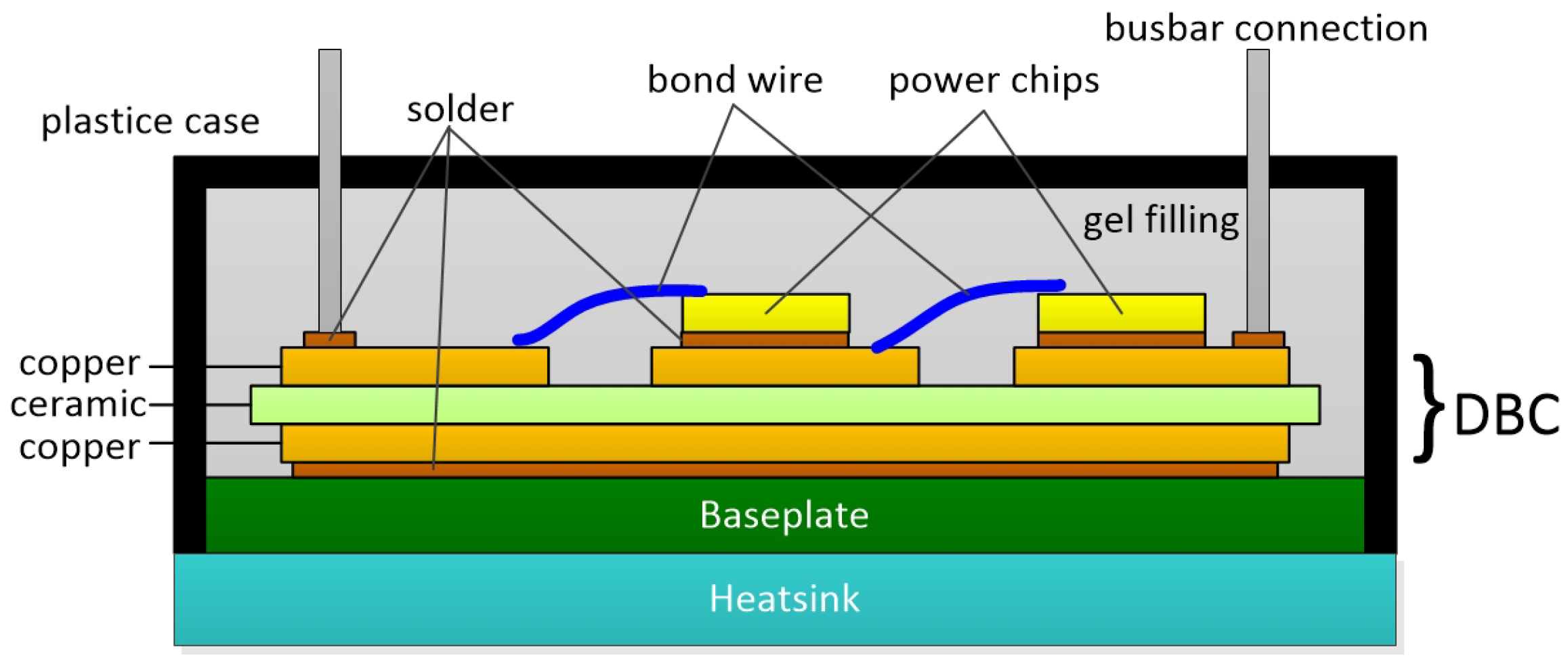


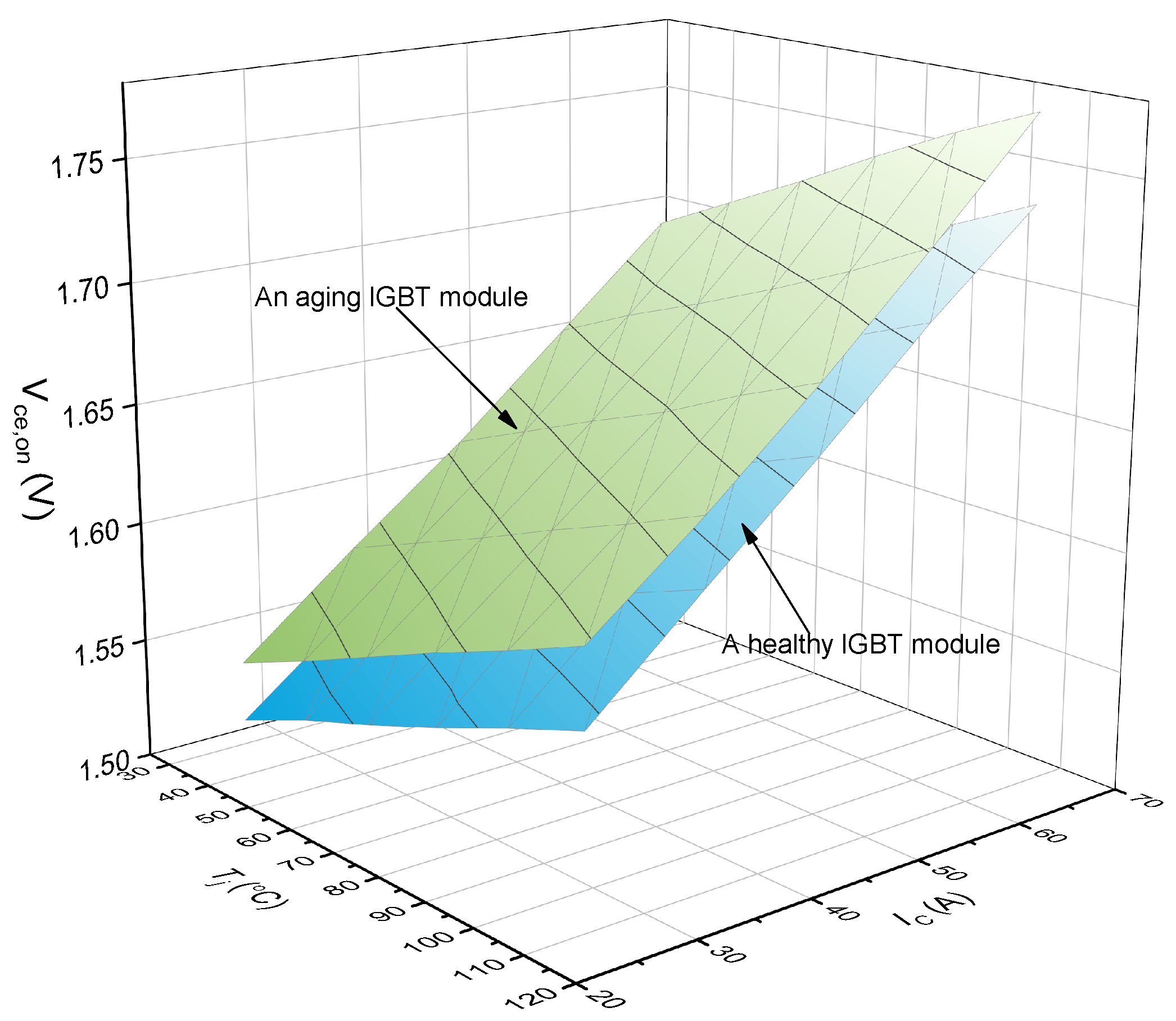

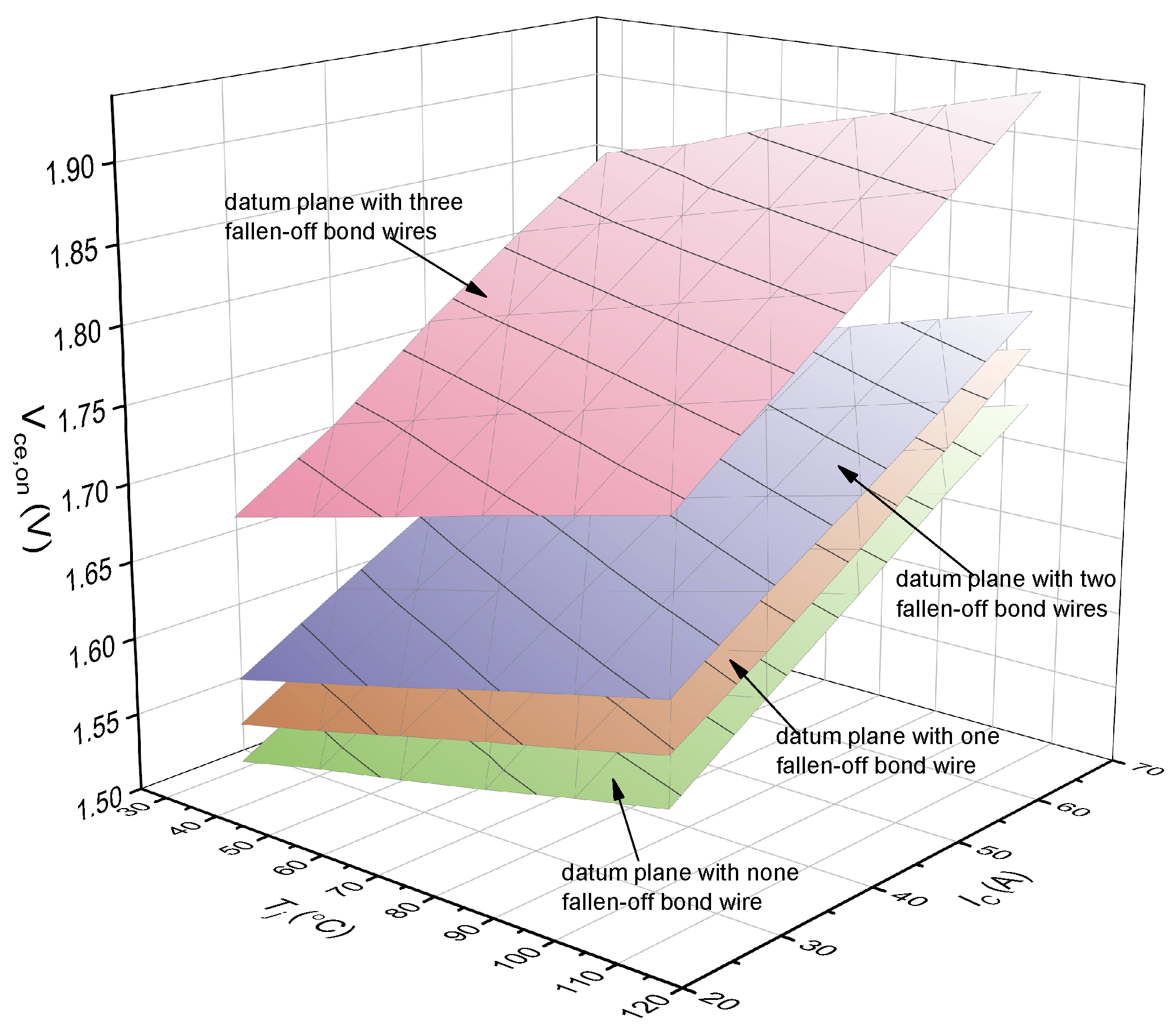


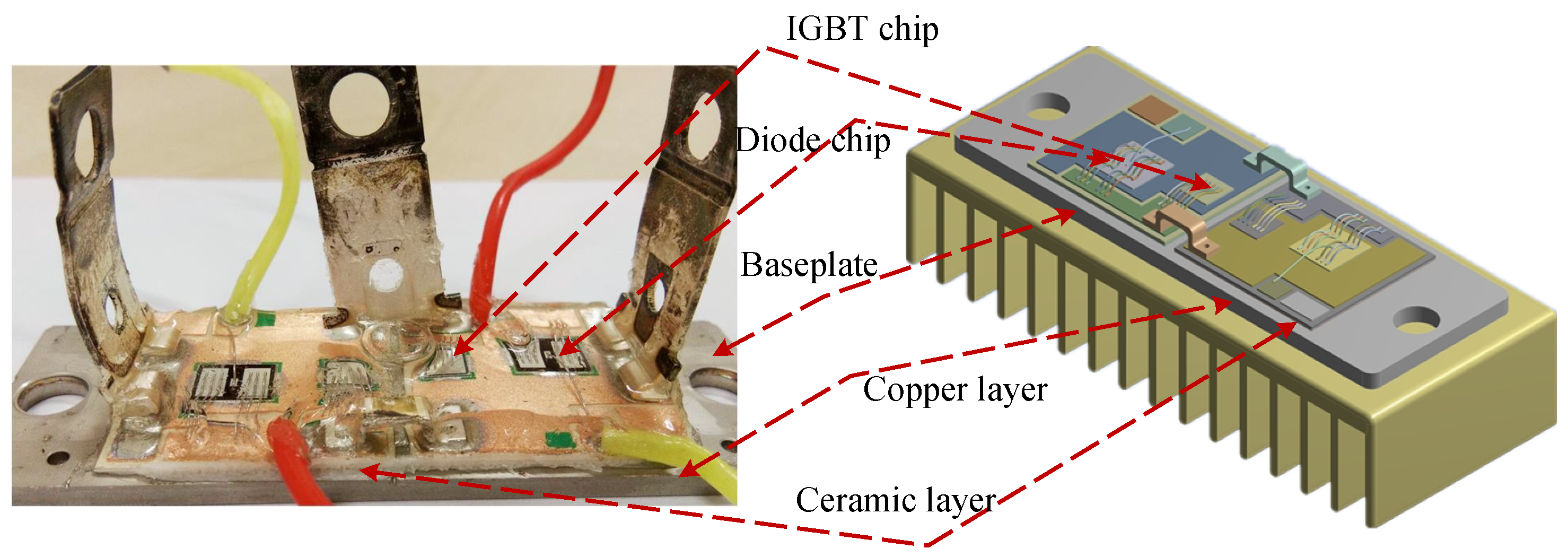


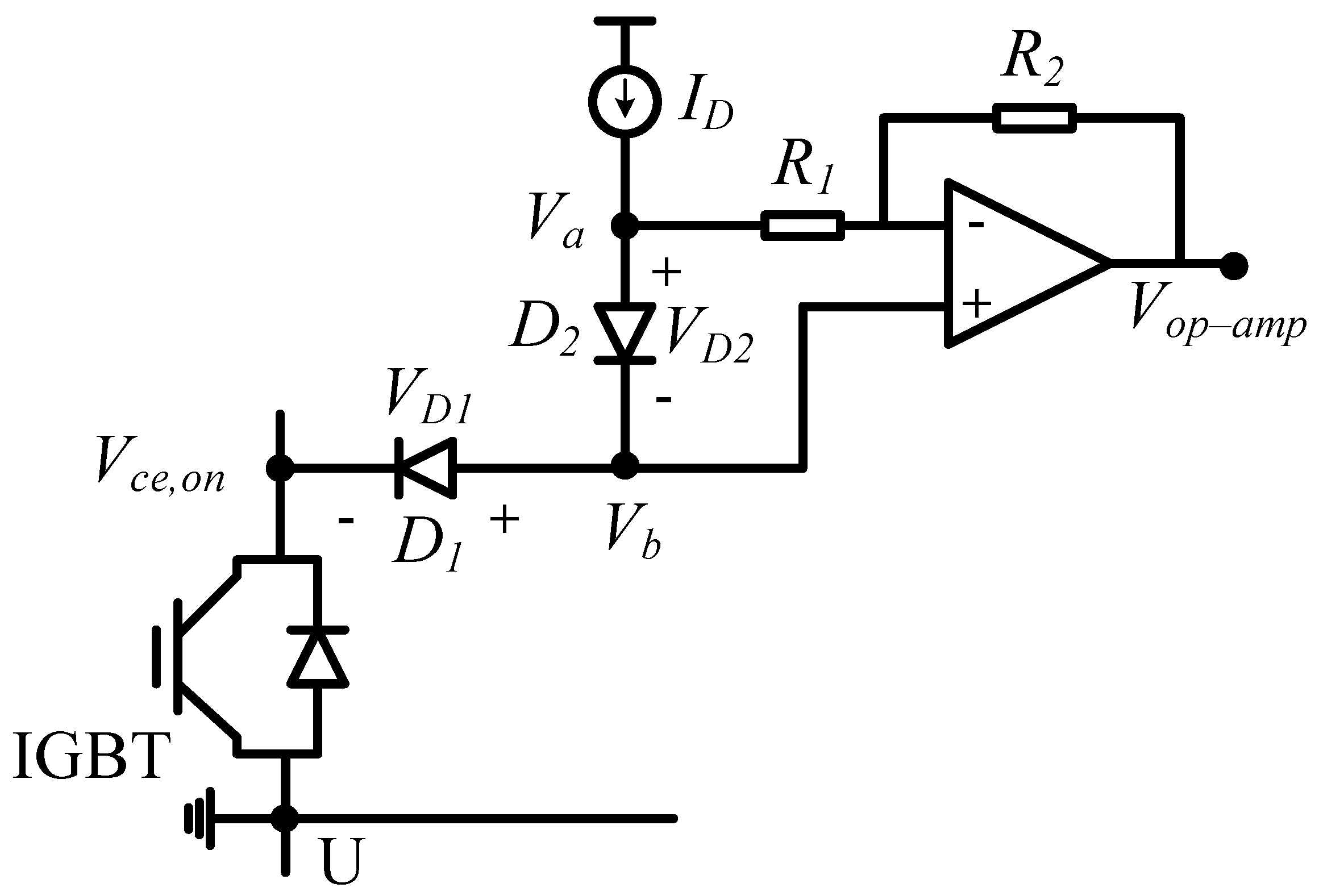


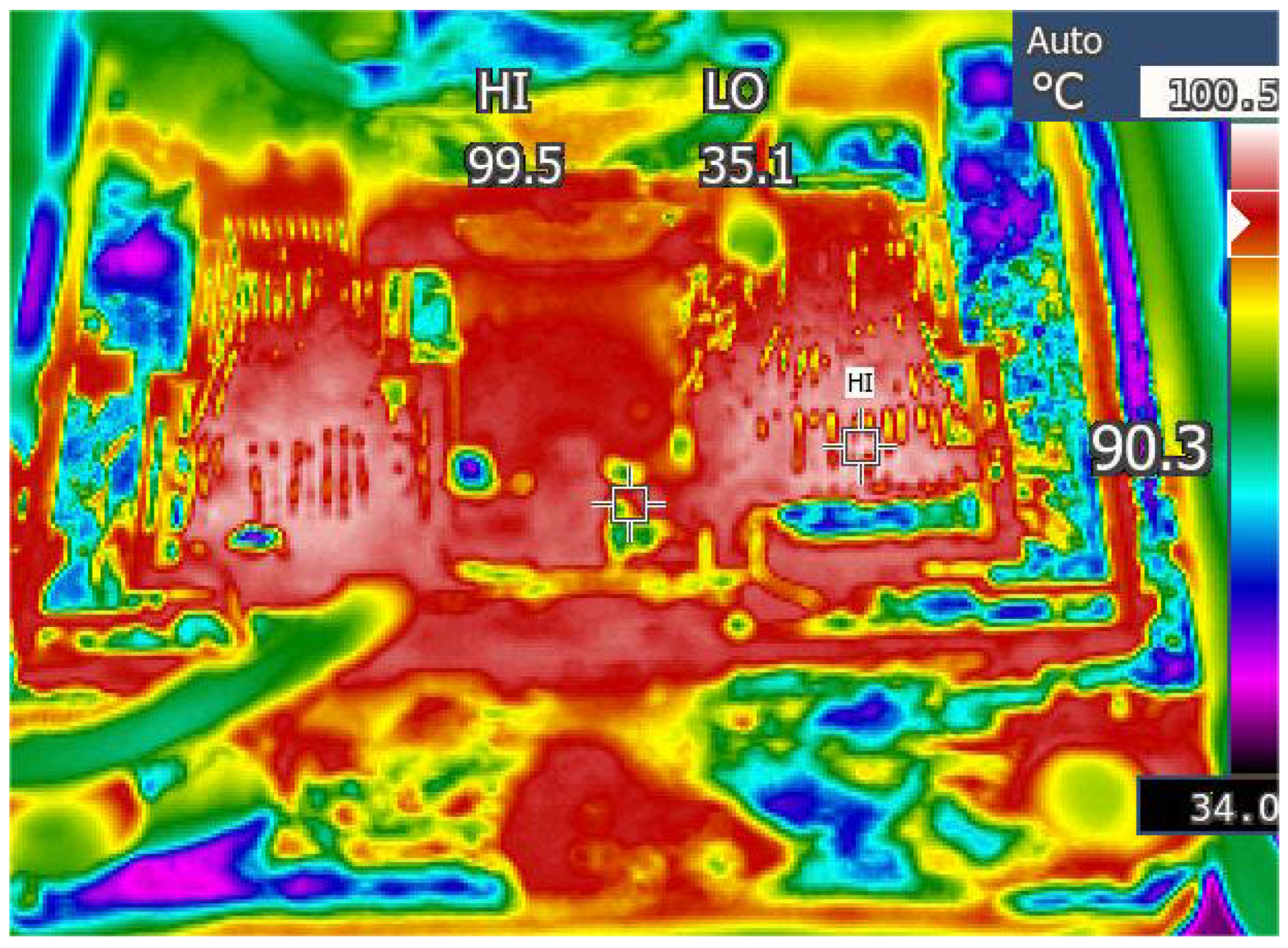
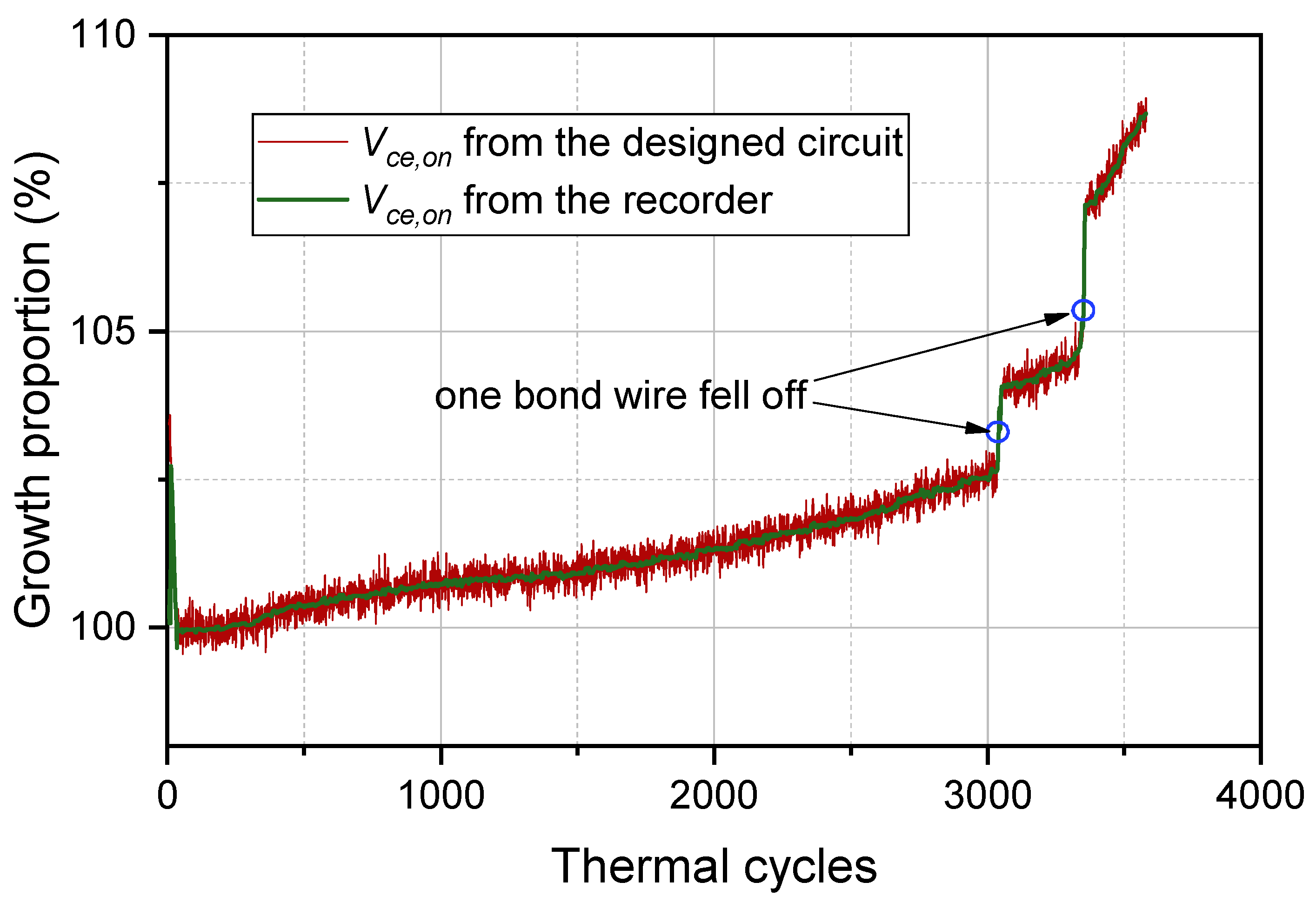

| 1 | 2 | 3 | 4 | |
|---|---|---|---|---|
| () | 0.18 | 0.064 | 0.022 | 0.004 |
| () | 0.182 | 0.75 | 0.36 | 1.25 |
Disclaimer/Publisher’s Note: The statements, opinions and data contained in all publications are solely those of the individual author(s) and contributor(s) and not of MDPI and/or the editor(s). MDPI and/or the editor(s) disclaim responsibility for any injury to people or property resulting from any ideas, methods, instructions or products referred to in the content. |
© 2024 by the authors. Licensee MDPI, Basel, Switzerland. This article is an open access article distributed under the terms and conditions of the Creative Commons Attribution (CC BY) license (https://creativecommons.org/licenses/by/4.0/).
Share and Cite
Hu, Z.; Cui, M.; Shi, T. Online Recognition of Fallen-Off Bond Wires in IGBT Modules. Micromachines 2024, 15, 404. https://doi.org/10.3390/mi15030404
Hu Z, Cui M, Shi T. Online Recognition of Fallen-Off Bond Wires in IGBT Modules. Micromachines. 2024; 15(3):404. https://doi.org/10.3390/mi15030404
Chicago/Turabian StyleHu, Zhen, Man Cui, and Tao Shi. 2024. "Online Recognition of Fallen-Off Bond Wires in IGBT Modules" Micromachines 15, no. 3: 404. https://doi.org/10.3390/mi15030404
APA StyleHu, Z., Cui, M., & Shi, T. (2024). Online Recognition of Fallen-Off Bond Wires in IGBT Modules. Micromachines, 15(3), 404. https://doi.org/10.3390/mi15030404






